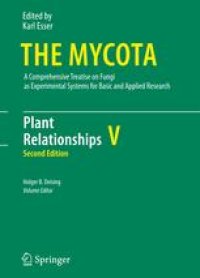
Ebook: Plant Relationships
- Tags: Eukaryotic Microbiology, Plant Pathology, Microbial Genetics and Genomics, Plant Physiology, Fungus Genetics, Plant Genetics & Genomics
- Series: The Mycota 5
- Year: 2009
- Publisher: Springer-Verlag Berlin Heidelberg
- Edition: 2
- Language: English
- pdf
Since the publication of the first edition of "The Mycota Vol. V – Plant Relationships" in 1997, tremendous advances in fungal molecular biology and biochemistry have taken place; and both light and electron microscopical techniques have improved considerably. These new insights led to a better understanding of the relationships between fungi and plants; and a completely revised new edition of Plant Relationships could be produced, providing an up-to-date overview on mutualistic and pathogenic interactions.
In 18 chapters internationally acknowledged authors present reviews on fungal lifestyles, mechanisms of their interactions with their host plants, signal perception and transduction, and plant defense responses directed against attack by fungal pathogens.
Highlighting the recent developments in fungus-plant interactions, this volume is indispensable for researchers, lecturers and students in microbiology, mycology and plant sciences, including plant pathology.
Since the publication of the first edition of "The Mycota Vol. V – Plant Relationships" in 1997, tremendous advances in fungal molecular biology and biochemistry have taken place; and both light and electron microscopical techniques have improved considerably. These new insights led to a better understanding of the relationships between fungi and plants; and a completely revised new edition of Plant Relationships could be produced, providing an up-to-date overview on mutualistic and pathogenic interactions.
In 18 chapters internationally acknowledged authors present reviews on fungal lifestyles, mechanisms of their interactions with their host plants, signal perception and transduction, and plant defense responses directed against attack by fungal pathogens.
Highlighting the recent developments in fungus-plant interactions, this volume is indispensable for researchers, lecturers and students in microbiology, mycology and plant sciences, including plant pathology.
Since the publication of the first edition of "The Mycota Vol. V – Plant Relationships" in 1997, tremendous advances in fungal molecular biology and biochemistry have taken place; and both light and electron microscopical techniques have improved considerably. These new insights led to a better understanding of the relationships between fungi and plants; and a completely revised new edition of Plant Relationships could be produced, providing an up-to-date overview on mutualistic and pathogenic interactions.
In 18 chapters internationally acknowledged authors present reviews on fungal lifestyles, mechanisms of their interactions with their host plants, signal perception and transduction, and plant defense responses directed against attack by fungal pathogens.
Highlighting the recent developments in fungus-plant interactions, this volume is indispensable for researchers, lecturers and students in microbiology, mycology and plant sciences, including plant pathology.
Content:
Front Matter....Pages i-xxii
Front Matter....Pages 1-1
Cellular and Molecular Biology of Phytophthora–Plant Interactions....Pages 3-27
Botrytis cinerea: Molecular Aspects of a Necrotrophic Life Style....Pages 29-50
Profiles in Pathogenesis and Mutualism: Powdery Mildews....Pages 51-68
The Uredinales: Cytology, Biochemistry, and Molecular Biology....Pages 69-98
The Sebacinoid Fungus Piriformospora indica: an Orchid Mycorrhiza Which May Increase Host Plant Reproduction and Fitness....Pages 99-112
Front Matter....Pages 113-113
Biomechanics of Spore Release in Phytopathogens....Pages 115-133
Gene for Gene Models and Beyond: the Cladosporium fulvum-Tomato Pathosystem....Pages 135-156
The cAMP Signaling and MAP Kinase Pathways in Plant Pathogenic Fungi....Pages 157-172
The Secretome of Plant-Associated Fungi and Oomycetes....Pages 173-180
From Tools of Survival to Weapons of Destruction: The Role of Cell Wall-Degrading Enzymes in Plant Infection....Pages 181-200
Photoactivated Perylenequinone Toxins in Plant Pathogenesis....Pages 201-219
Programmed Cell Death in Fungus–Plant Interactions....Pages 221-236
The Ectomycorrhizal Symbiosis: a Marriage of Convenience....Pages 237-257
Establishment and Functioning of Arbuscular Mycorrhizas....Pages 259-274
Epichloe Endophytes: Clavicipitaceous Symbionts of Grasses....Pages 275-306
Lichen-Forming Fungi and Their Photobionts....Pages 307-333
Front Matter....Pages 335-335
Signal Perception and Transduction in Plants....Pages 337-361
Defence Responses in Plants....Pages 363-385
Back Matter....Pages 387-398
Since the publication of the first edition of "The Mycota Vol. V – Plant Relationships" in 1997, tremendous advances in fungal molecular biology and biochemistry have taken place; and both light and electron microscopical techniques have improved considerably. These new insights led to a better understanding of the relationships between fungi and plants; and a completely revised new edition of Plant Relationships could be produced, providing an up-to-date overview on mutualistic and pathogenic interactions.
In 18 chapters internationally acknowledged authors present reviews on fungal lifestyles, mechanisms of their interactions with their host plants, signal perception and transduction, and plant defense responses directed against attack by fungal pathogens.
Highlighting the recent developments in fungus-plant interactions, this volume is indispensable for researchers, lecturers and students in microbiology, mycology and plant sciences, including plant pathology.
Content:
Front Matter....Pages i-xxii
Front Matter....Pages 1-1
Cellular and Molecular Biology of Phytophthora–Plant Interactions....Pages 3-27
Botrytis cinerea: Molecular Aspects of a Necrotrophic Life Style....Pages 29-50
Profiles in Pathogenesis and Mutualism: Powdery Mildews....Pages 51-68
The Uredinales: Cytology, Biochemistry, and Molecular Biology....Pages 69-98
The Sebacinoid Fungus Piriformospora indica: an Orchid Mycorrhiza Which May Increase Host Plant Reproduction and Fitness....Pages 99-112
Front Matter....Pages 113-113
Biomechanics of Spore Release in Phytopathogens....Pages 115-133
Gene for Gene Models and Beyond: the Cladosporium fulvum-Tomato Pathosystem....Pages 135-156
The cAMP Signaling and MAP Kinase Pathways in Plant Pathogenic Fungi....Pages 157-172
The Secretome of Plant-Associated Fungi and Oomycetes....Pages 173-180
From Tools of Survival to Weapons of Destruction: The Role of Cell Wall-Degrading Enzymes in Plant Infection....Pages 181-200
Photoactivated Perylenequinone Toxins in Plant Pathogenesis....Pages 201-219
Programmed Cell Death in Fungus–Plant Interactions....Pages 221-236
The Ectomycorrhizal Symbiosis: a Marriage of Convenience....Pages 237-257
Establishment and Functioning of Arbuscular Mycorrhizas....Pages 259-274
Epichloe Endophytes: Clavicipitaceous Symbionts of Grasses....Pages 275-306
Lichen-Forming Fungi and Their Photobionts....Pages 307-333
Front Matter....Pages 335-335
Signal Perception and Transduction in Plants....Pages 337-361
Defence Responses in Plants....Pages 363-385
Back Matter....Pages 387-398
....